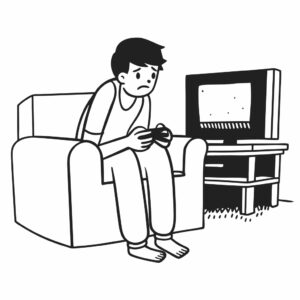Question More, Action Knowledge.
Remember, at QMAK, we don’t just teach; we empower. We don’t just inform; we inspire. We don’t just question; we act. Become a Gold Member, and let’s unlock your child’s full potential, one question at a time.
By the end of this lesson, students will:
Understand what cognitive biases are and how they affect decision-making.
Identify common types of biases that can influence thoughts and choices.
Learn strategies to recognize and overcome biases.
Apply critical thinking skills to make clearer, more objective decisions.

Let me show you something interesting. Take a look at this famous optical illusion:

What do you see in this picture? Some people see a young woman looking away, while others see an old woman with a large nose. Both are correct! This shows us something fascinating about how our brains work – they can trick us into seeing things in different ways.
Here’s another quick example:
If I asked you: “Which do you think happens more often – shark attacks or being hit by falling airplane parts?“
Most people quickly say shark attacks. But actually, you’re more likely to be hit by falling airplane parts! Our brains make quick judgments based on what we see in movies or news stories, even when those judgments aren’t accurate.
This is what we call a “cognitive bias” – it’s like a shortcut our brain takes when making decisions or judgments. Sometimes these shortcuts help us (like quickly jumping away from a snake-shaped stick), but sometimes they lead us to make mistakes.
Think about when you:
These are all examples of how our brains can jump to conclusions without having all the information.
Today, we’re going to learn about these brain shortcuts, why they happen, and how to catch ourselves when our brains might be tricking us into making not-so-great decisions.
What other times have you noticed your brain jumping to conclusions that turned out to be wrong?
Teaching Note: This opening helps students recognize that everyone’s brain uses these shortcuts, setting up the exploration of specific biases to come.
Alex’s jaw dropped. “That’s way too expensive for me,” they said.
“Oh, well in that case,” the salesperson replied, “let me show you this other great option. It’s only $500.”
Now here’s where something interesting happened in Alex’s brain. Suddenly, $500 didn’t seem so bad. After all, it wasn’t $900, right? Even though it was still $200 more than Alex had planned to spend, it felt like a “good deal” compared to that first expensive phone.

This is called the “anchoring bias” – when our brain gets stuck on the first number we hear (like that $900 price tag), and then judges everything else based on that number.
Think about it:
Let’s try an experiment:
Has this ever happened to you? Maybe when:
How could Alex have made a better decision? Maybe by:
Teaching Note: This story introduces anchoring bias through a relatable scenario that students might have experienced themselves.
You know how sometimes we take shortcuts when walking somewhere? Like cutting across the grass instead of following the sidewalk? Well, our brains take shortcuts too! These mental shortcuts are called “cognitive biases,” and while they can sometimes help us make quick decisions, they can also lead us down the wrong path.
Let’s look at some common brain shortcuts and how they work:
1. Confirmation Bias: “I’m Right Because I Want to Be Right!”
Think about this: You think vanilla ice cream is the best flavor. Every time someone says they love vanilla, you remember it. But when someone says they prefer chocolate, you ignore it. That’s confirmation bias – only paying attention to things that support what we already believe!
Example: “I knew that movie would be great because I love that actor. I don’t care what the bad reviews said!”

2. Anchoring Bias: “The First Thing Sticks!”
Remember Alex and the phone store? That’s anchoring bias – when the first thing we learn about something (like a price) affects all our other judgments.
Example: If someone first guesses a cat weighs 100 pounds, guesses after that tend to be too high, even though we know cats aren’t that big!

3. Availability Bias: “If I Can Think of It Easily, It Must Be Important!”
After watching a shark movie, you might be scared to go swimming – even though shark attacks are super rare! This happens because dramatic examples come to mind easily.
Example: “I’ll never ride a skateboard – my cousin broke his arm skating once!”

4. Bandwagon Effect: “Everyone’s Doing It!”
Have you ever wanted something just because all your friends had it? That’s the bandwagon effect – doing things because others are doing them.
Example: “I don’t even like this game, but everyone’s playing it, so I should too!”

5. Loss Aversion: “I Really Don’t Want to Lose!”
Most people would rather not lose $5 than find $5. Weird, right? That’s loss aversion – losses hurt more than similar gains feel good.
Example: “I’ll keep wearing these uncomfortable shoes because I spent money on them!”

Let’s try spotting these biases:
The cool thing is, just knowing about these biases helps us make better decisions! When we know our brain might be taking a shortcut, we can stop and think more carefully.
Teaching Note: Use examples relevant to students’ lives to make these abstract concepts concrete and relatable.
Case File #1: The Lucky Jersey
“Sam won a big game while wearing a specific jersey. Now he refuses to play without it, even when it’s in the wash or too hot to wear. Any time the team loses when Sam isn’t wearing it, Sam says ‘See? We lost because I didn’t wear my lucky jersey!’ But Sam ignores all the times they lost while wearing it.”
Let’s investigate:

Case File #2: The New Phone
“Everyone in Jamie’s class started getting the newest PhoneX. He already had a working phone but felt left out. Jamie spent all their savings to buy a PhoneX, even though they didn’t really need or want its features.”
Your detective work:

Case File #3: The Book Review
“Taylor starts reading book reviews for a book they really want to like. She read ten reviews – seven negative and three positive. Taylor decides the book must be good because ‘Look at these three great reviews!'”
Time to analyze:

For each case:
1. First, let’s spot the bias
2. Then, figure out how it’s affecting the decision
3. Finally, think about how to make a better choice
Let’s create our own “Bias Detective Toolkit” with strategies to overcome each bias:
Would you like to share a time when you caught yourself falling for one of these biases? What happened?
Teaching Note: Guide students through the process of identifying biases and developing practical strategies to overcome them in their own lives.
Now that we know about these brain shortcuts, let’s learn some clever ways to catch ourselves before they lead us to make not-so-great choices. Think of these strategies like having a mental “pause button”!
Strategy #1: The Pause and Think Method
When making a decision, stop and ask yourself:
Example: Before buying something because “everyone has it,” pause and think about whether YOU really want or need it.E

Strategy #2: The Detective’s Approach
Pretend you’re a detective gathering clues:
Example: If you think a subject is “too hard,” collect evidence of times you’ve learned difficult things before.

Strategy #3: The Flip-It Game
Try looking at situations from the opposite side:
Example: If you think someone doesn’t like you based on one interaction, imagine other reasons for their behavior.

Strategy #4: The Information Hunt
Before making big decisions:
Example: Before deciding a game isn’t worth playing because one friend didn’t like it, ask several other people about their experiences.

Let’s practice with a real situation:
“You want to quit piano lessons because you had one bad recital.“
How could we use these strategies?
What’s a decision you need to make soon? Which of these strategies could help you make a better choice?
Teaching Note: Encourage students to see these strategies as tools they can use right away in their daily decisions.
Today we discovered something fascinating about our minds – they often take shortcuts that can trick us into making choices we might regret later. We learned about different types of brain tricks (cognitive biases) and how to catch them in action!
Remember our key discoveries:
Over the next week, become a “Bias Detective” in your own life.
Keep a small journal and write down:

For example, you might write:
“Today I almost bought a cookie I didn’t really want just because my friend bought one (Bandwagon Effect). I stopped and asked myself if I was actually hungry, and decided to save my money instead!“
When we meet next time, we’ll learn about how to make complex decisions simpler. Bring your Bias Detective notes – I’d love to hear what you discovered about how your brain works!
Remember our strategies for catching biases:
What was the most surprising thing you learned about how our brains work? What bias do you think you’ll be most on the lookout for this week?
Try teaching someone else about one of the biases we learned today. Teaching others is one of the best ways to remember something new!
Teaching Note: This wrap-up reinforces key concepts while encouraging practical application in daily life. The take-home challenge promotes ongoing awareness and learning beyond the session.
Verse 1:
Five tricks that our minds might play
Making choices day by day
Confirmation tells us we’re right
Anchoring holds prices tight
While availability makes us think
What comes to mind must be the link
Pre-Chorus:
Time to be a detective now
Looking for the clues somehow
Of how our minds might play their games
As we make our choices day by day
Chorus:
Stop and think, gather your clues
Look at things from different views
Flip it round and hunt around
Till the truth is found
‘Cause our minds play tricks on us all
Making big things look so small
Or small things look so big and tall
When biases call
Verse 2:
Bandwagon says “Join the crowd”
Loss aversion speaks so loud
But with our detective toolkit near
We can make our thinking clear
Take a pause and gather facts
Before jumping into tracks
(Pre-Chorus)
(Chorus)
Bridge:
Like detectives on the case
We can solve these puzzles now
When we take the time to trace
All the why’s and how’s
(Chorus)
Outro:
Every clue helps point the way
To choices clear and true
When we spot these tricks each day
We know just what to do
Remember, at QMAK, we don’t just teach; we empower. We don’t just inform; we inspire. We don’t just question; we act. Become a Gold Member, and let’s unlock your child’s full potential, one question at a time.